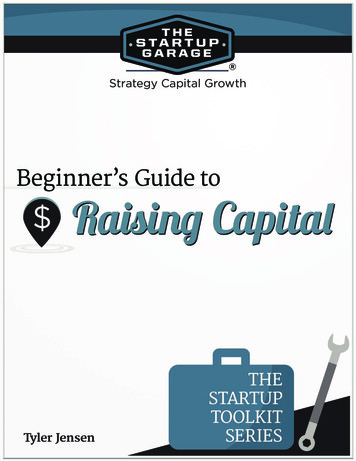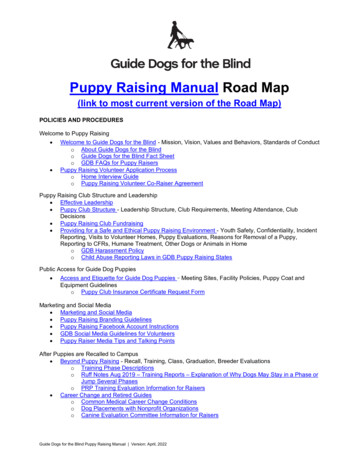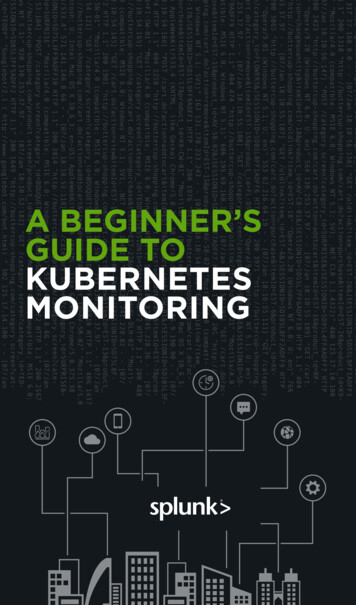
Transcription
THE STARTUP TOOLKI T SER IES Beginner’s Guide to Raising Capital 2The Startup Garage works with entrepreneurs in early stage,high-growth companies to attract investment and get out of the “garage.”We help startups achieve the milestones investors care about. Our teamhas helped raise over 200 million for startup businesses.Beginner’s Guide to Raising CapitalBeginner’s Guide to Raising Capital is a comprehensive resource forlearning the basics of the fundraising process. It contains actionable itemsto put new business on the path to reaching funding goals, and evencovers tips for maintaining personal mental health as an entrepreneur. Theend goal is to create a scalable, investor-ready startup — actively involvedin the community and ready to #GetFunded.The Startup Garage.com (858) 876 - 4597 2014 The Startup Garage — All rights reserved. This article may not be reprinted, reproduced,or retransmitted in whole or in part without the express written consent of the author.
THE STARTUP TOOLKI T SER IES Beginner’s Guide to Raising Capital 3Beginner’s Guide to Raising CapitalABOUT THE AUTHOR4Bio: Tyler JensenINTRODUCTION5Preparing for Fundraising7Milestone #1: Preparing Yourself9Milestone #2: Business Planning11Business PlanningFinancial ProjectionsCapital StrategyAlternative Sources of InvestmentValuationOther Investor DocumentsIdentifying Potential InvestorsPitchingDue DiligenceNegotiation StrategiesTerm SheetClosing the DealFollow-upMilestone #5: Market TractionSurveysBeta TestingCrowdfundingLetters of IntentContractsCompetitor Market TractionMilestone #6: Legal Foundation36Milestone #7: Operational System40What’s Next?42Conclusion46Milestone #3: Product Development 29Milestone #4: Team Building3330Partners/Co-FoundersKey StaffBoard of AdvisorsBoard of DirectorsBusiness Advisors and MentorsPersonal Support TeamProfessional Service ProvidersThe Startup Garage.com (858) 876 - 4597 2014 The Startup Garage — All rights reserved. This article may not be reprinted, reproduced,or retransmitted in whole or in part without the express written consent of the author.
THE STARTUP TOOLKI T SER IES Beginner’s Guide to Raising Capital 4About the Author“Starting a business is a very personal experience.I’m a serial entrepreneur and have started and helpedstart over one hundred businesses. I have a specialinterest in high-growth startups and have made it myobjective to understand what it is investors look forwhen evaluating the potential of a business. My goalis to coach entrepreneurs in scaling their startupswhile maintaining the work/life balance and achievingpersonal goals. In this book, I share my business planwriting process to start you off in the right direction.”-Tyler JensenTYLER JENSENIn 2008, Tyler founded The Startup Garage to help entrepreneurs and businessowners achieve success in their business ventures, as well as their lives. Tyler is aserial entrepreneur, having launched or help launch over 100 companies, includingnon-profits and social enterprises. He has developed an extensive network of businessrelationships focused on achieving the milestones investors care about.Tyler heads up The Startup Garage team, which has helped raise over 200 million forstartup businesses.The Startup Garage.com (858) 876 - 4597 2014 The Startup Garage — All rights reserved. This article may not be reprinted, reproduced,or retransmitted in whole or in part without the express written consent of the author.
THE STARTUP TOOLKI T SER IES Beginner’s Guide to Raising Capital 5IntroductionBeginner’s Guide to Raising Capital is for anyone looking to better understand thebest practices and processes of fundraising. Our goal in writing this is to create anessential resource for both the first time entrepreneur and the serial startup founder toreference when executing on raising capital in the real world.While you may find there are sections that don’t apply specifically to your startup,the content as a whole presents the process of fundraising every entrepreneur shouldknow. We encourage reading the whole thing!This guide is structured based on the seven milestones we’ve identified as the keyareas of focus when building a business; founder preparation, business planning,product development, team building, market traction, legal and operations.M ilestone #1: Pr e pa r ing You r sel fHere you will lay the foundation for building a successful startup around the keyingredient — YOU!Entrepreneurship is an exciting and exhilarating experience. However, failing toproperly assess yourself can lead to burnout in the future. We ask four importantquestions to ensure your personal foundation is solid.M ilestone #2: Business Pl a n n ingMany startups are entirely too product-focused. It is important to view your entity as abusiness that will continue to prosper. Walking through the basics will help you positionyour new venture the way investors want to see it — as profitable!M ilestone #3: Produc t Dev elopm en tNever assume that a product can sell itself or that the product development process isuniversal across all industries. This section will assist you in your research, specificallyfor your product and industry.The Startup Garage.com (858) 876 - 4597 2014 The Startup Garage — All rights reserved. This article may not be reprinted, reproduced,or retransmitted in whole or in part without the express written consent of the author.
THE STARTUP TOOLKI T SER IES Beginner’s Guide to Raising Capital 6M ilestone #4: T e a m Bu il dingFrom the very beginning, working on personal development is a must-do.You will identify and improve personal strengths, and just as importantly identify theareas you’re weak. Being uncomforably-honest with yourself will be greatly beneficialto your organization — helping to direct which areas to bring on team members.You will continue to open and cultivate new relationships. Being strategic about thiscould open doors to things you’d never think of otherwise.Here, we will help define individual leadership roles and titles within your organization.M ilestone #5: M a r k et T r ac t ionWhether or not you gain acceptance of your market will ultimately determine yoursuccess. Market traction comes in a variety of forms for different companies.In this section we clarify what form this might take in terms of your specifc startup,along with some proven ideas and tactics to present to potential investors.M ilestone #6: Lega lIt is extremely important to protect yourself with all the proper legal documents. Herewe cover the most commonly used legal documents in order to protect your startupbusiness and attract capital.M ilestone #7: Ope r at ionsEnsure your startup is setup for success with efficient and effective systems.This section will provide a comprehensive checklist for necessary operational systemsand structures for your startup. Congratulations! Familiarizing yourself with the important focus areas of capital raisingbrings you one step closer to reaching your goal.The Startup Garage.com (858) 876 - 4597 2014 The Startup Garage — All rights reserved. This article may not be reprinted, reproduced,or retransmitted in whole or in part without the express written consent of the author.
THE STARTUP TOOLKI T SER IES Beginner’s Guide to Raising Capital 7Preparing for FundraisingRaising capital for your startup can be an overwhelming and even mysterious projectfor most entrepreneurs. The intention of this eBook is to lay out the basics of thefundraising process so that you – the entrepreneur – understand the critical successfactors and the best practices, and can develop reasonable goals and expectationsabout the process.For a startup company, raising capital occurs in aseries of different investments throughout stages ofthe business lifecycle. For example, let’s say there isa new tech startup that raises 25,000 in funding fromtheir Friends, Family and other Co-Founders (FFF) soWant moreinformation?Access extensive capitalraising info and advice onour blog.TheStartupGarage.com/Blogthat they can get the business going. Within a yearthey may be making a profit, but they learn that theyneed additional funding so that they can continue togrow their business. At this point they seek out AngelInvestors for a seed round up to 1,000,000, followedby a series of large investments that can be well over 2 to 10 million from Venture Capitalist (VC) orFamily Offices typically called Series A, B, etc. In itssimplest form, the goal of your capital strategy is toreach a set of milestones that attract these differentinvestors so you can eventually raise the next round ofcapital. This eBook will elaborate on these milestonesin order to educate entrepreneurs on how to raisecapital effectively.It is impossible to discuss raising capital without putting into context the entire startupprocess. Raising capital is a by-product of adequately preparing your business andteam. Angel Investors and VCs are in the business of investing in companies thatpresent good “businesses to buy” (investment opportunities). Ideally they wantcompanies with a high growth model and an early exit strategy along with a greatproduct. Your job as an entrepreneur is to figure out what an investor wants to see inyour business and to put those features in place. The best approach towards obtaininginvestment is to focus less on hard selling tactics and instead more on building a greatinvestment opportunity and then deciding which investors are best for the company.The Startup Garage.com (858) 876 - 4597 2014 The Startup Garage — All rights reserved. This article may not be reprinted, reproduced,or retransmitted in whole or in part without the express written consent of the author.
THE STARTUP TOOLKI T SER IES Beginner’s Guide to Raising Capital 8In this eBook, we will discuss the entire startup process inside the context ofsuccessfully raising capital. This is done by organizing the startup process into 7 majorcategories with groups of individual milestones under each category. Please refer tothe following infographic for a high level description of the 7 major categories as theyrelate to each round of capital investment (one of the things to notice is that many ofthe milestones are prioritized and accomplished at the same time while others are donesimultaneously).The graphic below displays the funding milestones discussed in the last section. Asyou move up the rounds of funding, more and more will be expected to have beenaccomplished.STARTUPFUNDINGMILESTONEST he Sta rt u pTHEF u ndingM ilestonesf romT he Sta rt u p Ga r ageHelping founders achieve the milestones investors care about.SOURCE:VENTURECAPITALISTS 2 millionSERIES AUpdated BusinessPlanTested and ValidatedFinancial ModelFull C SuiteExpanded BODSignificant Revenue/User AcquisitionUnderstandCustomer CPAExpanded BOAFinancial Plan forRapid ScalingPatent(s) AcquiredHR InfrastructureMitigated Legal &Political RisksKey Hire PlanContinuous ProductIterationsCultureImplementationTerm SheetInvestment OfferingDocumentsBasic BookkeepingProduct LaunchReporting SystemBeta ProductUnderstandFundraisingInsuranceWorking MVPPrototypeIP StrategyIT InfrastructureIncorporationPhone Number &AddressPrototype (working ornon-working)Understand FinancialKey BenchmarksConcept ResearchFounder PersonalCash Flow PlanSecurityUnderstandCustomer LTVSOURCE:ANGELINVESTORS 100k—1mANGELInvestor DeckValuationCapital StrategyFull 5 year FinancialProjectionsKey ManagementPositionsUnderstand SalesCycleCEO/COOPaid UsersBODBeta TestingBOAFull-scale MarketingPlanFull Business PlanIP Acquisition inProgressValuationBasic ManagementSkillsEmployee ContractsProven SignificantMarket OpportunityClearly DefinedAddressable MarketSOURCE:FAMILY,FRIENDS &FOUNDERS 10k—100kSEEDFinancial ProjectionsCofounderBasic Business PlanAdvisorMentorCPA/ AttorneyFounderMarketing LaunchPlanSecondary MarketResearchFounders AgreementPrimary Research —Informal SurveysBasic Patent Searchby FounderMARKETTRACTIONLEGALBusiness LicenseIdeaOPERATIONSPRODUCTDEVELOPMENTLaunc MILESTONESBUSINESSPLANNINGTEAM BUILDINGFOUNDERLEADERSHIPFor more info on funding, give us a call (858) 876-4597 or visit our website at TheStartupGarage.comThe Startup Garage.com (858) 876 - 4597 2014 The Startup Garage — All rights reserved. This article may not be reprinted, reproduced,or retransmitted in whole or in part without the express written consent of the author.
THE STARTUP TOOLKI T SER IES Beginner’s Guide to Raising Capital 9MILESTONE #1: PREPARING YOURSELF“ Twenty years from now you will be more disappointed by the thingsthat you didn’t do than by the ones you did do.So throw off the bowlines.Sail away from the safe harbor.Catch the trade winds in your sails.Explore. Dream. Discover.”- Mark TwainSelf-preparation often tends to be overlooked and undervalued, despite being arguablythe most important milestone of them all. Preparing yourself and making sure yourother co-founders are on the same page is extremely critical for building a successfulstartup. In the first few rounds of fundraising the investors determine how much theybelieve the current team will be able to build a successful company.The Startup Garage.com (858) 876 - 4597 2014 The Startup Garage — All rights reserved. This article may not be reprinted, reproduced,or retransmitted in whole or in part without the express written consent of the author.
THE STARTUP TOOLKI T SER IES Beginner’s Guide to Raising Capital 10can you answer these 4 important questions?1. How will your personal bills be paid during the firstcouple years of business operations where you probablywon’t be able to take money out of the company?2. Are you trying to grow as quickly as possible andprepare the company for a sale or IPO within 5 years?Or are you determined to build a solid business and workat it until you retire?3. Does your company align with your passion, experience,and goals?4. Is your target market large enough and business modelappropriate to scale to a size that will achieve yourpersonal financial goals as well as the financial goals ofWant to connecton LinkedIn?M eet Ty le r onL in k edInwww.linkedin.com/in/tylerwjensenpotential investors?From the Startup Toolkit:Entrepreneur Self Analysis ToolEntrepreneur HealthYou will want to a take a sober and realistic look at your current state of health.This includes mental, emotional, spiritual, and physical health. Are you and your cofounders currently in a state of health that will allow for the strenuous endeavor of startinga new company? Ask your friends and family if they believe you are ready for this.Personal Support TeamIn addition to your health you will also want to take an assessment of your personal supportteam. This is different from your business support team which will be discussed later. Thisincludes people like family, friends, doctors, coaches, trainers, pastors or spiritual leaders,and therapists. Each entrepreneurs’ personal support team will look a little different.When times get tough (which they will) having these relationships in place could mean thedifference between overcoming obstacles and closing the business. Make sure to get theirsupport in your new endeavor. If you find them lukewarm to the idea ask them why. Theymay see blind spots you are unaware of that would prevent you from being successful.The Startup Garage.com (858) 876 - 4597 2014 The Startup Garage — All rights reserved. This article may not be reprinted, reproduced,or retransmitted in whole or in part without the express written consent of the author.
THE STARTUP TOOLKI T SER IES Beginner’s Guide to Raising Capital 11MILESTONE #2: BUSINESS PLANNING“The only place where success comesbefore work is in the dictionary.”-Vidal SassoonThe second milestone is business planning, which – when done appropriately – willlead and direct your focus on the rest of the milestones. You will begin this milestoneat the beginning and finish it last. In order to complete the business plan you mustsimultaneously complete many other milestonesThe entire business planning process that we have laid out will hopefully highlight themajor gaps in your own business that must be achieved to raise investment.The Startup Garage.com (858) 876 - 4597 2014 The Startup Garage — All rights reserved. This article may not be reprinted, reproduced,or retransmitted in whole or in part without the express written consent of the author.
THE STARTUP TOOLKI T SER IES Beginner’s Guide to Raising Capital 12BUSINESS PLANNING“If you fail to plan, you are planning to fail.”- Benjamin FranklinEvery entrepreneur should begin planning their business by researching the competition,the industry, and the market. This is one of the most time consuming pieces of thebusiness planning phase and corners should not be cut. The information you learn herebecomes the foundation for many decisions you will make later on. We’ve provided anoverview of this research process below, but you can learn more about it on our eBook:Business Plan Basics.Compet i t i v e A na lysisThe Competitive Analysis assesses the differences between your business and yourcompetition, while detecting and examining the factors that cause these differences. Thissection is broken down into direct and indirect competitors, and it is intended to give youinsight for how to go head-to-head with these competitors in order to acquire customers.It is also used to show your advantages over your customers as well as how you aredifferentiated from them.Indust ry A na lysisThe Industry Analysis analyzes the conditions of your industry in its current moment. Thisincludes the behavior and relations between competitors, suppliers, and consumers. It isvital to understand the different factors at work — political, economic, and environmental— within a given industry in order to create an effective strategic plan for any company.First, define what type of industry you are in, and then determine what sector of theindustry you will operate within. Once you figure this out, you can determine the currentand projected size of the industry and sector as well as start researching which factors canpotentially impact your business, the other major players in the industry, and any relevanttrends that will affect these industry players.The Startup Garage.com (858) 876 - 4597 2014 The Startup Garage — All rights reserved. This article may not be reprinted, reproduced,or retransmitted in whole or in part without the express written consent of the author.
THE STARTUP TOOLKI T SER IES Beginner’s Guide to Raising Capital 13M a r k et A na lysisThe Market Analysis is used to define and determine the potential appeal of numerousmarkets, and to understand those markets’ evolving opportunities and threats in relationto the strengths and weaknesses for a particular company. The focus of this sectionshould be on the people you intend to sell your products/services to, known as your targetmarket. This can include individual customers – known as business to customer (B2C) –or other businesses – known as business to business (B2B). In a way, the Market Analysisis the foundation of your business’ plan of attack.Produc t Descr i p t ionThe Product Description clearly explains what products or services your business will offer.The information provided in this section will become the basis of your Marketing Plan. It’snever safe to assume that your product/service will sell itself, so make sure to include athorough description using specifics and detailed language. It should be written so thatthe reader can easily understand what the product is and what it does (features). Itshould also include a comparison of your product to other similar products on the market.This is your opportunity to clearly define the advantages your product has over anycompetitors, as well as to highlight any weaknesses that you would like to improve upon.FINANCIAL PROJECTIONS“An entrepreneur without funding is a musician without an instrument.”- Robert A. Rice Jr.You will need to create financial projections, which is where the remaining milestonescome into play. Accurately projecting your financial statements is an extremely importantpart of your business plan. It gives insight on how your business will perform financiallyaccording to the current market assumptions and the business model you choose.You will have to accomplish many of the other milestones in order to complete theseaccurately. For example, the first thing you need to do is create the revenue model, andyou’re required to know your market size, marketing plan, and sales plan in order to dothis (See how to create a revenue model blog post here for more information). Then,The Startup Garage.com (858) 876 - 4597 2014 The Startup Garage — All rights reserved. This article may not be reprinted, reproduced,or retransmitted in whole or in part without the express written consent of the author.
THE STARTUP TOOLKI T SER IES Beginner’s Guide to Raising Capital 14when you’re putting together your sales projections, you will need to know your pricingstrategy and cost of goods sold (COGS). This continues to occur in sections later onwhere you need to know your organizational chart and job descriptions so you can mapout your 5 year personnel expenses.You also need to create a 5 year month-to-month Balance Sheet, Income Statement– also referred to as the Profit and Loss (P&L) – and Cash Flow Statement. Other keymetrics that should be included are startup expenses, marketing goals, unit sales andcosts, and personnel expenses. You can learn more about this in our eBook Business PlanBasics.Upon completion of the financials projections, you will be able to write the operations,management, sales, marketing, and financial summary sections of the business plan.Take a look at our Sample Business Plan for a more thorough understanding of thevarious sections of the plan.CAPITAL STRATEGY“If you’re not learning while you’re earning, you’re cheatingyourself out of the better portion of your compensation.”- Napoleon HillThe Startup Garage.com (858) 876 - 4597 2014 The Startup Garage — All rights reserved. This article may not be reprinted, reproduced,or retransmitted in whole or in part without the express written consent of the author.
THE STARTUP TOOLKI T SER IES Beginner’s Guide to Raising Capital 15Once you complete your financials projections and your business plan you will find thatyou have an understanding of how much money you need and at what stage you needit. The next step is to develop your capital strategy, which includes asking yourself thefollowing questions: What type of investment am I looking for? Debt or Equity? What type of investors am I seeking? What is the current valuation of my business? How much equity am I willing to give up? How can I find and approach investors? What do I say once I’m in a meeting? What legal documents will I need to close the deal? What are the terms of thedeal?Knowing the questions themselves is key at this stage. You will be able to find out manymore details in the following eBooks once you are ready on each of those questions:Busi n ess Pl a nBa sic sGu i de to R a isi ngC a p i ta l f romFa m i ly, F r i e n ds &Fou n de r sGu i de to R a isi ngC a p i ta l f romA nge l I n v estor sThe Startup Garage.com (858) 876 - 4597 2014 The Startup Garage — All rights reserved. This article may not be reprinted, reproduced,or retransmitted in whole or in part without the express written consent of the author.C row df u n di ng101
THE STARTUP TOOLKI T SER IES Beginner’s Guide to Raising Capital 16A MOUNT TO RAISEKnowing how much capital to raise is difficult to determine because there really is noright answer. It’s all dependent on what type of industry you are in, what your personaland financial goals are, what stage your company is at in development, what your capitalstrategy is, etc. With that said, your financial projections will answer this question to thebest of your ability based on the assumptions that you make throughout the projections(revenue growth model, COGS, personnel plan, marketing plan, operating expenses, etc).DEBT/ EQUIT YSimilar to figuring out how much capital you need to raise, there is no right answer fordetermining the percentage of capital you raise through debt vs. equity. It all depends onwhat you are more comfortable with and the risks you are willing to take.Because debt comes in the form of a loan, you are able to retain the equity share of thecompany, which doesn’t dilute your ownership. However, you must re-pay the loans withinterest even if you go out of business (assuming the loan is a personal loan and not abusiness loan, which is usually the case for most entrepreneurs because these are theonly type of loans you will have access to). Debt is a better choice for someone who isThe Startup Garage.com (858) 876 - 4597 2014 The Startup Garage — All rights reserved. This article may not be reprinted, reproduced,or retransmitted in whole or in part without the express written consent of the author.
THE STARTUP TOOLKI T SER IES Beginner’s Guide to Raising Capital 17looking to stay with the company long term, as opposed to an early exit strategy.Equity on the other hand is capital that doesn’t have to be paid back. However, it willdilute your shares and lessen the amount you earn upon exit.TYPES OF INVESTORSFA M ILY, FRIENDS, AND FOUNDERS (FFF)Roughly 50% of startups receive investments/ funding from friends and family membersin the beginning of their venture. According the Global Entrepreneurship Monitor (Babson& London School of Business), 50 billion to 75 billion is invested annually in thismanner. This is over double the amount of capital invested annually by angel investors orventure capitalists (approximately 20 billion).FFF capital should be used to achieve the milestones that will attract seed funding fromangel investors. Likewise, angel funding should be used to achieve the milestones thatwill attract Series A funding from venture capitalists. Normal amounts raised from FFFrange from 25,000 to 50,000. See our Guide to Friends, Family, and Founders formore information.ANGEL INVESTORSAngels can also be thought of as private investors that provide financial backing forstartup companies. By definition, Angels are accredited investors, meaning their networth (either alone or combined with their spouse) exceeds 750,000 at the time ofinvestment, or they have an annual income that exceeds 200,000 ( 300,000 if combinedwith spouse) for the two preceding years.Angels aren’t professional investors working for an outside company. Rather, they investtheir own money into the startups, which is why they invest at earlier stages and don’tprovide as much funding as a venture capitalist. Normal amounts raised from angelsrange from 250,000 to 750,000. It is also common for multiple Angels to pool theirmoney together, either informally or formally via an Angel Investment Group.See our eBook Guide to Raising Capital from Angel Investors for more information.The Startup Garage.com (858) 876 - 4597 2014 The Startup Garage — All rights reserved. This article may not be reprinted, reproduced,or retransmitted in whole or in part without the express written consent of the author.
THE STARTUP TOOLKI T SER IES Beginner’s Guide to Raising Capital 18VC’SVenture Capitalists (VCs) invest significantly more than FFF and Angel Investors, butthey typically do it at a later stage when the company has a higher valuation. They canrepresent outside companies, groups of wealthy investors, investment banks, or otherfinancial groups that pool investments or partnerships. The downside for entrepreneurs isthat they usually require a higher level of inclusion in company decisions (if not majoritycontrol) and seek significant amounts of equity in the company. Normal amount raisedfrom VCs range 3,000,000 to 10,000,000.FA M ILY OFFICESA family office or better known as single family office (SFO) are private companies thatmanage the investments of certain families that have accumulated wealth or trustsover many generations. Unlike angels and VCs, family offices don’t have the handson experience with starting a business so they may not be able to provide the valuableguidance that many startups desperately need.CROWDFUNDINGA major benefit to Crowdfunding platforms is that they can bring in investors whonormally wouldn’t have uncovered the company on their own. Until fairly recently, youcould only act as an equity investor if you were accredited (which requires an income ofat least 200,000 per year). However, because of the JOBS act, regular people are nowallowed to invest with more flexibility.The Startup Garage.com (858) 876 - 4597 2014 The Startup Garage — All rights reserved. This article may not be reprinted, reproduced,or retransmitted in whole or in part without the express written consent of the author.
THE STARTUP TOOLKI T SER IES Beginner’s Guide to Raising Capital 19A truly successful crowdfunding campaign is one that has momentum and is being sharedamongst many social channels. Another pro of crowdfunding is that it often established adegree of market traction when it comes to raising capital from more traditional sources.See our Crowdfunding 101 eBook for more information.COR P ORATE INVESTINGMany large corporations have investments groups that make strategic investments intoearly stage companies. Each group usually has clearly defined criteria in what, when,and how much they invest. You will have to do some good old fashioned research ofcompanies that may be interested in investing in your startup.ALTERNATIVE SOURCES OF CAPITALThere are also a number of other alternative sources of capital including credit cards,inventory loans, etc. You can see dozens of these in the eBook Alternative sources ofCapital.VALUATIONSome say that
Beginner’s Guide to Raising Capital is a comprehensive resource for . . reference when executing on raising capital in the real world. . Angel Investors and VCs are in the business of investing










